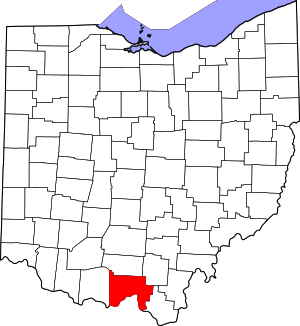Portsmouth, Ohio
Portsmouth is a city in and the county seat of Scioto County, Ohio, United States.[6] Located in southern Ohio 41 miles (66 km) south of Chillicothe, it lies on the north bank of the Ohio River, across from Kentucky, just east of the mouth of the Scioto River. The population was 20,226 at the 2010 census.
Portsmouth, Ohio | |
|---|---|
| City of Portsmouth | |
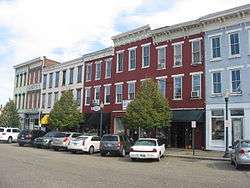 A view of Market Street Plaza in the Boneyfiddle neighborhood | |
| Nickname(s): P-Town | |
| Motto(s): "Where Southern Hospitality Begins" | |
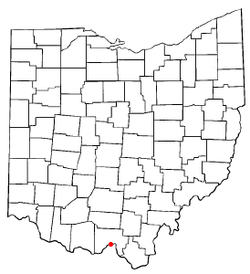 Location in the state of Ohio | |
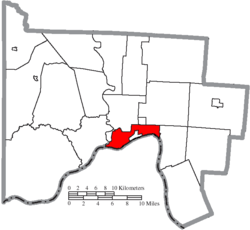 Location of Portsmouth in Scioto County | |
| Coordinates: 38°44′35″N 82°57′56″W | |
| Country | United States |
| State | Ohio |
| County | Scioto |
| Founded | 1803 |
| Incorporated | 1815 |
| Government | |
| • Type | Council–manager |
| • City Manager | Sam Sutherland |
| Area | |
| • Total | 11.07 sq mi (28.66 km2) |
| • Land | 10.73 sq mi (27.79 km2) |
| • Water | 0.34 sq mi (0.87 km2) |
| Elevation | 533 ft (162 m) |
| Population | |
| • Total | 20,226 |
| • Estimate (2019)[3] | 20,158 |
| • Density | 1,878.83/sq mi (725.41/km2) |
| Time zone | UTC-5 (EST) |
| • Summer (DST) | UTC-4 (EDT) |
| ZIP code | 45662 |
| Area code(s) | 740 |
| FIPS code | 39-64304[4] |
| GNIS feature ID | 1061567[5] |
| Website | portsmouthoh |
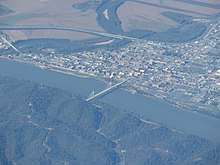
History
Foundation
The area was occupied by Native Americans as early as 100 CE, as indicated by the Portsmouth Earthworks, a ceremonial center built by the Ohio Hopewell culture between 100 and 500 CE.[7]
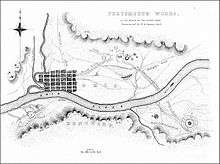
According to early 20th-century historian Charles Augustus Hanna, a Shawnee village was founded at the site of modern-day Portsmouth in late 1758, following the destruction of Lower Shawneetown by floods.[8]
European-Americans began to settle in the 1790s after the American Revolutionary War, and the small town of Alexandria was founded.[9] Located at the confluence, Alexandria was flooded numerous times by the Ohio and the Scioto rivers.
In 1803, Henry Massie found a better location slightly east and somewhat removed from the flood plains. He began to plot the new city by mapping the streets and distributing the land. Portsmouth was founded in 1803 and was established as a city in 1815. It was designated as the county seat. Settlers left Alexandria, and it soon disappeared.
The Ohio state legislature passed "Black Laws" in 1804 that restricted movement of free blacks and required persons to carry papers, in an effort to dissuade blacks from settling in the state. These provisions were intermittently enforced by local governments and law enforcement, and sometimes used as an excuse to force African Americans out of settlements. In 1831, Portsmouth drove out African Americans from the city under this pretext. Many settled several miles north in what became known as Huston's Hollow, along the Scioto River. Its residents, especially Joseph Love and Dan Lucas, provided aid to refugee slaves in the following years and assisted them in moving north.[10]
Although southern Ohio was dominated in number by anti-abolitionist settlers from the South, some whites also worked to improve conditions for blacks and aid refugee slaves. Portsmouth became important in the antebellum years as part of the Underground Railroad. Fugitive slaves from Kentucky and other parts of the South crossed the Ohio River here. Some found their future in Portsmouth; others moved north along the Scioto River to reach Detroit, Michigan, and get further away from slave catchers. Many continued into Canada to secure their freedom.[11] A historical marker near the Grant Bridge commemorates this period of Portsmouth's history.[12] James Ashley of Portsmouth continued his activism and pursued a political career. After being elected to Congress, he wrote the Thirteenth Amendment, which abolished slavery in 1865 after the American Civil War.[13]
Portsmouth quickly developed an industrial base due to its location at the confluence of the Ohio and Scioto rivers. Early industrial growth included having meat packing and shipping facilities for Thomas Worthington's Chillicothe farm, located north of Portsmouth on the Scioto River. The city's growth was stimulated by completion of the Ohio and Erie Canal in the 1820s and 1830s,[14] which provided access to the Great Lakes, opening up northern markets.
But the construction of the Norfolk and Western (N&W) railyards beginning in 1838 and the completion of the Baltimore and Ohio Railroad (B&O) junction at the city in the late 1850s quickly surpassed the canal in stimulating growth. The railroads soon carried more freight than the canal, with the B&O connecting the city to the Baltimore and Washington, DC markets. By the end of the 19th century, Portsmouth became one of the most important industrial cities on the Ohio River between Pittsburgh, Pennsylvania and Cincinnati, Ohio. It became an iron and steel factory town with new companies like the Portsmouth Steel Company.
20th century
The city's growth continued. By 1916, during World War I, Portsmouth was listed as being a major industrial and jobbing center, the fourth-largest shoe manufacturing center in the country, and the largest manufacturer of fire and paving bricks in the United States. Wheeling-Pittsburgh Steel (later called Empire-Detroit Steel) employed over one thousand people. There were 100 other manufacturing companies producing goods from furniture to engines.[15]
Such industrial and shipping growth greatly benefited Boneyfiddle (a west-end neighborhood in Portsmouth), where grand buildings were constructed with the wealth from the commerce. As time passed, much of the commerce began to move toward Chillicothe Street, which has continued as the main thoroughfare of Portsmouth. While Boneyfiddle is receiving new life, it is a shadow of its former self.
The city population peaked at just over 42,000 in 1930 (see "Demographics", below). In 1931, the Norfolk Southern Corporation built a grand, art deco passenger station in Portsmouth, that provided a substantial entry to the city. It was located at 16th and Findlay streets. Passengers used the station for access to both interstate and intrastate train lines, which provided basic transportation for many. The widespread availability of affordable automobiles and changing patterns resulted in reduction in rail passenger traffic here and nationally. The station was later used for offices and its keys were turned over to Scioto County in 2003, and the building was demolished in 2004.[16]
Suburbanization also affected the city. By the 1950 census, the population had begun to decline, falling below 40,000. Some of this change was due to the effects of highway construction, which stimulated suburban residential development in the postwar years. But during the late 20th century, foreign competition and industrial restructuring resulted in the loss of most of the industrial jobs on which Portsmouth's economy had been based; the jobs were moved out of the area, with many going overseas.
Further decline occurred in 1980, following the suspension of operations at Empire Detroit Steel's Portsmouth Works, which took place after the sale of the steel plant to Armco Steel. Armco Steel closed the plant because they did not want to replace the obsolete, Open Hearth Furnaces with the more efficient basic oxygen steel furnaces. The plant also needed a continuous caster to replace the obsolete soaking pits and blooming mill in 1995. When the steel mill was closed, 1,300 steelworkers were laid off.
21st century
As of 2010, Portsmouth has a population of approximately 20,000. It has shared in the loss of jobs due to unskilled labor outsourcing and population migration to more populous urban areas. Despite its relatively small size, Portsmouth has been a regular stop for recent Presidential campaigns of the 21st century. In September 2004, George W. Bush visited the city as part of his reelection campaign.[17] Vice Presidential candidate John Edwards also visited Portsmouth that month.[18] The campaigns of 2008 resulted in numerous candidates and surrogates visiting Portsmouth, and some spoke at Shawnee State University: Bill Clinton on behalf of his wife Hillary Clinton,[19] Republican candidate John McCain,[20] and US Senator Barack Obama,[21] who won the election. In 2012, candidate Mitt Romney spoke at Shawnee State University.[22] In March 2016, Bill Clinton visited Portsmouth again to campaign for his wife, presidential candidate Hillary Clinton.[23]
Portsmouth, and other parts of Scioto County, have worked to redevelop blighted properties and create a new economy. After the Scioto County Port Authority secured an initial $30,000 grant from the Scioto Foundation, the Scioto County Land Reutilization Corporation received $2.725 million from the Ohio Housing Finance Agency (OHFA) through the Neighborhood Initiative Program (NIP).[24] Along with adapting disused residential properties, Portsmouth has begun the process of transforming abandoned industrial and commercial properties to other uses.
Its industrial past resulted in environmental problems at some sites. Portsmouth was one of 172 communities to receive 279 grants totaling $56.8 million in EPA Brownfields funding through the Environmental Protection Agency's Assessment and Cleanup Grants. The Southern Ohio Port Authority (SOPA) received grant funding in 2017 of $300,000 as part of a program offered through the EPA in an effort to cleanup former industrial sites for other uses. These funds provide aid to under-served and economically disadvantaged communities through the assessment and cleanup of abandoned industrial and commercial properties. They expand the ability of communities to recycle vacant and abandoned properties for new, productive reuses.[25]
The city has also initiated new developments in its downtown. The Ohio Legislature passed House Bill 233 on April 20, 2016 to authorize cities to create Downtown Redevelopment Districts. They operate similarly to a Tax Increment Finance (TIF) District. The city of Portsmouth formed a Downtown Redevelopment District (DRD) in 2017 in the Boneyfiddle neighborhood of the city to increase investment and development there.[26]
Through the early 21st century, there has been a noticeable increase in investment in Portsmouth's local economy. The Southern Ohio Port Authority has worked with the Joint Economic Development Initiative of Southern Ohio (JEDISO) to secure funding for local business. A grant through JEDISO from the Fluor-BWXT Opportunity was awarded to YEI Technology, PatterFam Sauces, Tri-America Contractors, Appalachian Wood Flooring (Phase 1) and Columbia Gas Regional Headquarters. The grants resulted in 48 jobs created and 225 jobs retained.[27] New investments and developments in the local economy led to Portsmouth's inclusion in Site Selection Magazine's "Top 10 Micropolitan areas". Celina, Defiance and Portsmouth were among a group of cities tied for 10th. Portsmouth attracted nine significant economic development projects in 2016, nearly as many as it had from 2004-2013 combined.[27][28]
In 2014, Portsmouth was one of 350 cities to enter a submission in the America's Best Communities competition, hoping to win the $3 million first place prize.[29] In April 2015, Portsmouth was chosen as one of the 50 quarter-finalists, winning $50,000 to help prepare a Community Revitalization Plan.[29] In January 2016, Portsmouth's plan, which emphasized using its most valuable asset, the Ohio River, as a key to revitalizing the city, earned it one of 15 spots in the competition's semi-finals.[30] In April 2016, Portsmouth was one of seven cities eliminated at the semi-final round, but received an additional $25,000 for use in continuing to develop its plans to improve commercial and community access to the Portsmouth riverfront by making the port a premier regional destination for industrial development, small business development, and riverfront recreation.[30]
Demographics
| Historical population | |||
|---|---|---|---|
| Census | Pop. | %± | |
| 1820 | 527 | — | |
| 1830 | 1,378 | 161.5% | |
| 1840 | 1,544 | 12.0% | |
| 1850 | 4,011 | 159.8% | |
| 1860 | 6,268 | 56.3% | |
| 1870 | 10,592 | 69.0% | |
| 1880 | 11,321 | 6.9% | |
| 1890 | 12,394 | 9.5% | |
| 1900 | 17,870 | 44.2% | |
| 1910 | 23,481 | 31.4% | |
| 1920 | 33,011 | 40.6% | |
| 1930 | 42,560 | 28.9% | |
| 1940 | 40,466 | −4.9% | |
| 1950 | 36,798 | −9.1% | |
| 1960 | 33,637 | −8.6% | |
| 1970 | 27,633 | −17.8% | |
| 1980 | 25,993 | −5.9% | |
| 1990 | 22,676 | −12.8% | |
| 2000 | 20,909 | −7.8% | |
| 2010 | 20,226 | −3.3% | |
| Est. 2019 | 20,158 | [3] | −0.3% |
| Sources:[4][31][32] | |||
2010 census
As of the census[2] of 2010, there were 20,226 people, 8,286 households, and 4,707 families residing in the city. The population density was 1,885.0 inhabitants per square mile (727.8/km2). There were 9,339 housing units at an average density of 870.4 per square mile (336.1/km2). The racial makeup of the city was 90.1% White, 5.1% African American, 0.4% Native American, 0.6% Asian, 0.7% from other races, and 3.0% from two or more races. Hispanic or Latino of any race were 2.2% of the population.
There were 8,286 households, out of which 28.5% had children under the age of 18 living with them, 33.9% were married couples living together, 17.5% had a female householder with no husband present, 5.4% had a male householder with no wife present, and 43.2% were non-families. 35.9% of all households were made up of individuals, and 15.5% had someone living alone who was 65 years of age or older. The average household size was 2.28 and the average family size was 2.93.
The median age in the city was 36.1 years. 21.6% of residents were under the age of 18; 14.3% were between the ages of 18 and 24; 23.6% were from 25 to 44; 24.2% were from 45 to 64; and 16.4% were 65 years of age or older. The gender makeup of the city was 46.4% male and 53.6% female.
2000 census
As of the census[4] of 2000, there were 20,909 people, 9,120 households, and 5,216 families residing in the city. The population density was 1,941.4 people per square mile (749.6/km2). There were 10,248 housing units at an average density of 951.5 per square mile (367.4/km2). The racial makeup of the city was 91.50% White, 5.00% African American, 0.63% Native American, 0.61% Asian, 0.02% Pacific Islander, 0.32% from other races, and 1.92% from two or more races. Hispanic or Latino of any race were 0.93% of the population.
There were 9,120 households, out of which 25.9% had children under the age of 18 living with them, 37.9% were married couples living together, 15.6% had a female householder with no husband present, and 42.8% were non-families. 37.3% of all households were made up of individuals, and 17.8% had someone living alone who was 65 years of age or older. The average household size was 2.19 and the average family size was 2.87.
In the city the population was spread out, with 22.0% under the age of 18, 11.3% from 18 to 24, 25.9% from 25 to 44, 21.2% from 45 to 64, and 19.6% who were 65 years of age or older. The median age was 38 years. For every 100 females, there were 83.8 males. For every 100 females age 18 and over, there were 78.3 males.
The median income for a household in the city was $23,004, and the median income for a family was $31,237. Males had a median income of $31,521 versus $20,896 for females. The per capita income for the city was $15,078. About 18.3% of families and 23.6% of the population were below the poverty line, including 31.1% of those under age 18 and 14.5% of those age 65 or over.
Geography

Portsmouth is at the confluence of the Ohio, Scioto, and Little Scioto rivers. It is a midway point among four major cities: Charleston, West Virginia, Cincinnati and Columbus, Ohio; and Lexington, Kentucky, each of which are approximately ninety miles away (roughly a two-hour drive).
Much of the terrain is quite hilly due to dissected plateau around it. Both rivers have carved valleys and Portsmouth lies next to both the Scioto and Ohio rivers. It is within the ecoregion of the Western Allegheny Plateau.[33] According to the United States Census Bureau, the city has a total area of 11.07 square miles (28.67 km2), of which 10.73 square miles (27.79 km2) is land and 0.34 square miles (0.88 km2) is water.[34]
Neighborhoods
- Sciotoville - located 5 miles (8.0 km) in the eastern part of Portsmouth off US 52 at Ohio 335; it is sometimes known as East Portsmouth, but it is within the city limits, with about 10% of the city's population living there.
- North Moreland - a community within Portsmouth, north of the Village of New Boston. North Moreland connects the larger western section of Portsmouth with Sciotoville.
- Boneyfiddle - several blocks west of downtown Portsmouth, generally centered around the Market St./2nd St. intersection
- Hilltop - residential neighborhoods in Portsmouth located north of 17th St., west of Thomas Ave and east of Scioto Trail
Government
City government
The city charter was adopted on November 6, 1928. The city conducts business at their city hall, which was constructed in 1935. City council meetings are held during the second and fourth weeks in the month. The city reverted from being run by a city manager to a mayor in 1988, with the mayor being elected every four years.
In 2012 voters approved returning to a Council/City Manager form of government; this took effect in January 2014. Under the City Manager/Council system, the mayor and vice-mayor are elected members of the city council who are appointed to their positions by the council. The city manager is hired by and reports directly to the council. The city manager oversees the day-to-day operations of city government and is the direct supervisor of all city department heads. There are six wards in the city with elections of council members from the wards every two years.
The City Manager is Sam Sutherland.[35]
| Ward | City Councillor |
|---|---|
| First Ward | Sean Dunne |
| Second Ward | Charlotte Gordon |
| Third Ward | Kevin E. Johnson (Acting Mayor) |
| Fourth Ward | Andrew McManus |
| Fifth Ward | Edwin Martell |
| Sixth Ward | Thomas Lowe |
County government
Portsmouth is the county seat for Scioto County. The courthouse is located at the corner of Sixth and Court Streets and was constructed in 1936. The sheriff's office and county jail, once located in the courthouse, are located in a new facility, constructed in 2006 at the former site of the Norfolk and Western rail depot near U.S. 23.
County Commissioners:
Bryan K. Davis, Chairman
Michael Crabtree
Cathy E. Coleman
The county commissioners meet twice weekly on Tuesday and Thursdays at 9:30 am in room 107 on the first floor of the Scioto County Courthouse.
Economy
Portsmouth major employers include Southern Ohio Medical Center, Kings Daughters Medical Center, Shawnee State University, Norfolk Southern Corp.(Railroad), Southern Ohio Correctional Facility and OSCO Industries. In November 2002, the Portsmouth Gaseous Diffusion Plant in nearby Piketon, Ohio was recognized as a Nuclear Historic Landmark by the American Nuclear Society. It had served a military function from 1952 until the mid-1960s, when the mission changed from enriching uranium for nuclear weapons to one focused on producing fuel for commercial nuclear power plants. The Portsmouth Gaseous Diffusion Plant ended enriching operations in 2001 and began to support operational and administrative functions and perform external contract work. The site is currently being cleaned up for future development by Fluor/ B&W.
Graf Brothers Flooring and Lumber, the world's largest manufacturer of rift and quartered oak products, has two satellite log yards in Portsmouth, with the company's main office being located across the river in South Shore, Kentucky. Portsmouth is the home of Sole Choice Inc., one of the largest manufacturers of shoelaces in the world.
Transportation


Highways
Portsmouth is served by two major U.S. Routes: 23 and 52. Other significant roads include Ohio State Routes 73, 104, 139, 140, and 335. The nearest Interstate highway is I-64. Interstate 73 is planned to use the newly built Portsmouth bypass (i.e., Ohio State Route 823) en route from North Carolina To Michigan. The I-74 Extension is planned to use US 52 through Portsmouth, running concurrently with I-73 on the eastern side of Portsmouth
Rail
Portsmouth is an important location in the Norfolk Southern Railway network. Norfolk Southern operates a railyard and locomotive maintenance facility for its long-distance shipping route between the coalfields of West Virginia and points east, to the Great Lakes. Competitor CSX Transportation operates a former Chesapeake & Ohio Railway line just east of the city in Sciotoville, which crosses the Ohio River on the historic Sciotoville Bridge. Amtrak offers passenger service to the Portsmouth area on its Cardinal route between New York City and Chicago. The passenger station is located on CSX Transportation-owned track in South Shore, Kentucky, across the Ohio River from Portsmouth.
Air
Portsmouth is served by the Greater Portsmouth Regional Airport (PMH), a general aviation airport. The airport is located in Minford, Ohio, approximately 12 miles (19 km) northeast of the city. The nearest commercial airport is Tri-State Airport (HTS) in Ceredo, West Virginia, approximately 3 miles (4.8 km) outside Huntington, West Virginia and 53 miles (85 km) southeast of Portsmouth.
Public transportation
Public transportation for Portsmouth and its outlying areas is offered through Access Scioto County (ASC).[37]
Education
Colleges and universities
Portsmouth is the home of Shawnee State University, a public institution established in 1986. It is Ohio's thirteenth and newest institution of higher education.[38]
K-12 schools
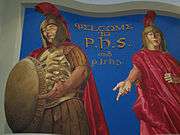
Portsmouth has one public and two private school systems (the Notre Dame schools and the Portsmouth STEM Academy). The Portsmouth City School District has served the city since its founding in the 1830s and is the public school in the city. Portsmouth City School District is notable having a storied basketball tradition by winning four OSHAA State Basketball Championships in 1931, 1961, 1978, and 1988.[39] The Trojan basketball team has made 14 final four appearances, they are 1925, 1926, 1927, 1929, 1931 (1st), 1934 (2nd), 1939, 1941, 1961 (1st), 1978 (1st), 1980 (2nd), 1988 (1st), 1990 (2nd).[40] and 2012 (2nd). The Trojan football team has also produced some notable teams as of late with an Associated Press Division 3 State Championship in 2000, a regional title, and state semi-final appearance in 2000, and finishing as regional runner up in both 2001, and 2002. In all the Trojans football team has sent 5 teams to the post season since 2000, as of the start of the 2009 season.[41][42]
In 2000, Portsmouth voters passed a much needed school bond issue, which helped construct new schools for the district. The new schools opened for the 2006–2007 school year. These schools won the Grand Prize from School Planning & Management's 2007 Education Design Showcase. The award is awarded annually to the K-12 school that displays "excellence in design and functional planning directed toward meeting the needs of the educational program."[43][44] In addition, the school system plans to build a new $10 million athletic complex.[45] Portsmouth High School has an award-winning Interactive Media program that has won multiple awards for both video and graphic design. The class is under the direction of Chris Cole and the students run the local cable station TNN CH25.
In 2009 the school system completed construction on a new $10 million athletic complex. The 25-acre (10 ha) Clark Athletic Complex[46] has a new football field, baseball field, softball field, tennis courts, and track.[45] The complex is named for Clyde and Maycel Clark of the Clark Foundation, major financial contributors for the construction of the facility.[47] The new complex, situated on the site of the former high school building and across the street from the current high school, has three paintings by mural artist Herb Roe, a 1992 Portsmouth High School alumnus.[48] The murals depict three of the sports played at the new facility: baseball, tennis, and football.
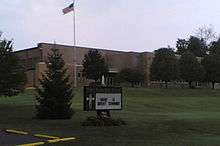
Notre Dame (Catholic) Schools(formerly Portsmouth Central Catholic HS) have served the city's Roman Catholics and others since 1852. It is also notable for its football team, founded in 1929. It won two state championships in 1967 and 1970.[39]
Prescription drug epidemic
We have a very high addiction rates in addition to the death rates. A lot of young people are addicted. Our treatment facilities are overwhelmed. The court systems are overwhelmed.
— Lisa Roberts, registered nurse with the Portsmouth City Health Department (2010)[49]
Since the late 1990s, an epidemic of prescription drug abuse has swept the town and surrounding areas.[50] It has caused a dramatic increase in Hepatitis C cases in the county,[51] drug-related deaths,[52] robberies,[53][54][55] murder,[56] and an increased incidence of children born addicted to prescription drugs.[50]
For a number of years, the most prevalent drug was oxycodone, a synthetic opiate known colloquially as oxys and hillbilly heroin, because of the drug's association with Appalachian areas of Kentucky, Ohio, Pennsylvania, Virginia, and West Virginia.[57] An April 2011 special episode of the television series Intervention, "Intervention In-Depth: Hillbilly Heroin", focused on Portsmouth.[58] It explored the effects of prescription drug abuse on residents of the town and surrounding area.[59] In a May 2019 investigative story, The Washington Post reported that fentanyl, a synthetic opioid 50 times more potent than oxycodone,[60] had become the deadly drug of choice in Ohio, contributing to nearly 21,000 opiate overdose deaths in the United States in the first part of 2018.[61]
In 2011 the DEA and state and local law enforcement agencies worked to crack down on the problem, with the DEA serving Immediate Suspension Orders (suspension of their license to practice medicine) on four local doctors and a pharmacy in Scioto County. In a press release, the DEA said that one of the targets, Dr. Temponeras, was one of the largest dispensers of controlled substances in the US, while two others, Dr. Fantazuzzi and Dr. Dawes, had prescribed hundreds of thousands of opiates over a two-year period.[62]
The support group SOLACE formed in Portsmouth in 2010 to tackle this problem, helping to raise public awareness of the issue and lobbying the state house for legislation.[63] Governor John Kasich referred to the group in his 2011 State of the State Address, and members of the group were featured in the A&E documentary entitled Intervention In-Depth: Hillbilly Heroin (2011).[64] While SOLACE's efforts have been promoted as an example of how a small, dedicated group could effect real change in their community,[65] Ohio voters in 2011 rejected a proposed $1 million drug prevention tax levy backed by SOLACE and other anti-drug abuse organizations.[66]
In May 2011 the Ohio Senate and House unanimously passed a bill, authored by Portsmouth's representative in the Ohio House, Dr. Terry Johnson, and signed into law by Governor Kasich, cracking down on pill mills by regulating of pain clinics and the ability of prescribers to personally furnish controlled substances.[67][68]
Despite all these efforts, by 2019 the ten areas with the highest rates of fatal overdoses in the nation were located in a near-contiguous stretch from St. Louis, through one county in Kentucky, five counties in Ohio, two counties in West Virginia, and reaching to Baltimore.[61] While Portsmouth's Scioto County did not happen to be in the worst ten for 2019, it is in the middle of this death zone, within a few miles of six of the deadliest counties on the list.[61] Generations of poverty have helped to create an underground economy supporting the distribution of illegal substances.[69]
Culture
Buildings and landmarks
Many historical buildings in Portsmouth have been demolished because of poor upkeep, other city development, or the completion of new buildings that replaced the landmarks. Landmarks that have been demolished include the old Norfolk & Western rail depot, churches dating back to the early 20th century, houses dating to the 1850s, Grant Middle School, and the old Portsmouth High School and various elementary schools.
Many buildings survive from the early 19th century. Old churches are among the reminders of Portsmouth's past and identity. The historic 1910 Columbia Theater was destroyed by a fire in 2007, later demolished and rebuilt in 2012 as the open air Columbia Music Hall, with a refurbished façade from the original structure serving as the entry point.[70][71][72] Other noted historic buildings include the old monastery, which can be seen for miles, and Spartan Stadium, as well as numerous buildings in the Boneyfiddle Historic District, which is listed on the National Register of Historic Places. In 1982, students from Miami University conducted research on several of Portsmouth's most important historic buildings. This work resulted in an exhibition at the Miami University Art Museum and a book entitled Portsmouth: Architecture in an Ohio River Town.[73] The Portsmouth Public Library is the city's library, founded in 1879. It has branch libraries throughout Scioto County. The Southern Ohio Museum, founded in 1979, has more than sixty exhibits on display including artwork by Clarence Holbrook Carter and Jesse Stuart, China dolls, Native American artifacts, and works by local artists.
In October 2016, a professor at Shawnee State University submitted a proposal to the State Farm Neighborhood Assist grant program, to preserve Spartan Municipal Stadium.[74] The stadium opened in 1930 as the original home of the Portsmouth Spartans, now the fifth oldest active franchise in the National Football League (as the Detroit Lions).[74] In November 2016, the city won a $25,000 State Farm Neighborhood Assist grant toward the stadium's renovation.[75]
Indian Head Rock
The Indian Head Rock is an eight-ton sandstone boulder which until 2007 rested at the bottom of the Ohio River. Historically, the boulder was used to record low river stages. It is notable due to its history and due to the figures and names of individuals which were carved into the rock at times of low water levels. In 1917, the construction of a dam downriver from Portsmouth meant that the rock would forever be submerged, if not for its recovery by a group of local divers led by an Ironton historian. The removal of the rock led the states of Kentucky and Ohio into a legislative battle to determine its ownership and disposition.[76] The rock was returned to the state of Kentucky in 2010.
City parks
Portsmouth has fourteen parks for residents and community use. These include Alexandria Park (Ohio and Scioto River confluence), Bannon Park (near Farley Square), Branch Rickey Park (on Williams Street near levee), Buckeye Park (near Branch Rickey Park), Cyndee Secrest Park (Sciotoville), Dr. Hartlage Park (Rose Street in Sciotoville), Labold Park (near Spartan Stadium), Larry Hisle Park (23rd Street & Thomas Ave.), Mound Park (17th & Hutchins Streets), York Park (riverfront), Spartan Stadium, Tracy Park (Chillicothe & Gay Streets), and Weghorst Park (Fourth & Jefferson Streets).[77]
Greenlawn Cemetery
This active cemetery was established in 1829. Greenlawn is 40 acres in size and is the only public cemetery in the city of Portsmouth. This cemetery incorporates several smaller cemeteries, which are sections of Greenlawn Cemetery. Sections included in Greenlawn Cemetery are: City, Evergreen, Hebrew, Holy Redeemer, Hill North (Methodist), Hill South (Robinson), Old Mausoleum, Soldiers Circle, and St. Marys. The cemetery is located at Offnere Street and Grant Street. It is maintained by the City of Portsmouth.
Floods and floodwalls
Although developed on higher ground, the city has been subject to seasonal flooding. The city had extensive flooding in 1884, 1913, and 1937. After the flood of 1937, the U.S. Army Corps of Engineers constructed a floodwall protecting the city, which prevented two major floods in 1964 and 1997.
In 1992, the city of Portsmouth began honoring some of the many accomplishments of its area natives by placing a star on the riverside of the floodwall. This is known as the Portsmouth Wall of Fame and was instituted by then-mayor Frank Gerlach. Some of the honorees include Don Gullett, Al Oliver, and former United States Vice-President Dan Quayle, who was not a Portsmouth native.[78]
In 1992 a nonprofit group headed by Dr. Louis R. Chaboudy was formed to investigate developing a mural-based tourist attraction on the floodwall. In the spring of 1993, mural artist Robert Dafford was commissioned and began painting murals of Portsmouth's history. He hired local art student Herb Roe as an assistant. Roe subsequently apprenticed to and worked for Dafford for 15 years.[79] The project eventually spanned sixty 20 feet (6.1 m) tall consecutive Portsmouth murals, stretching for over 2,000 feet (610 m).[80] Subjects covered by the murals span the history of the area from the ancient mound building Adena and Hopewell cultures to modern sporting events and notable natives.
These subjects include
- The Portsmouth Earthworks, a large mound complex constructed by the Ohio Hopewell culture from 100 BCE to 500 CE.
- Lower Shawneetown, a Shawnee village that straddled the Ohio River just downstream during the late 18th century.
- The 1749 'Lead Plate Expedition' to advance France's territorial claim on the Ohio Valley, led by Pierre Joseph Céloron de Blainville.
- Tecumseh, a Shawnee leader who directed a large tribal confederacy that opposed the United States during Tecumseh's War and the War of 1812. He grew up in the Ohio country during the American Revolutionary War and the Northwest Indian War.
- Henry Massie, a founding father of the town and surveyor who laid out the original plat in 1803.
- A Civil War unit from Portsmouth, Battery L, fighting at Gettysburg
- Jim Thorpe, a Native American athlete who played as the player/coach of the semi-professional Portsmouth Shoesteels in the late 1920s.
- The Portsmouth Spartans, a member of the NFL from 1929–1933; the organization later moved to Detroit to become the Detroit Lions.
- Branch Rickey, influential baseball coach, inventor of the farm team system, and the signer of Jackie Robinson to Major League Baseball; Robinson broke the baseball color line when he debuted with the Brooklyn Dodgers in 1947.
- Clarence Holbrook Carter, an American Regionalist and surrealist painter.
- Carl Ackerman, local photographer and historic photo collector, whose collection was used for many of the river murals.
- The disastrous Ohio River flood of 1937, which led to the construction of the floodwall.
- Transportation – stagecoaches, riverboats, railroads and the Ohio and Erie Canal, which had its terminus just outside Portsmouth.
- Local notables including Roy Rogers, Jesse Stuart, Julia Marlowe, and Vern Riffe.
- Other panels explore the local history of education, the first European settlers, industries (including the steel industry, shoe industry, and the Portsmouth Gaseous Diffusion Plant), sister cities, the local Carnegie library, firemen and police, period genre scenes of old downtown and other localities, and a memorial to area armed forces veterans.
The original mural project was finished in the fall of 2003. Since then several additional panels have been added, including murals honoring Portsmouth's baseball heroes in 2006; and the Tour of the Scioto River Valley (TOSRV), a bicycle tour between Columbus and Portsmouth in 2007.[81]
Professional sports
Portsmouth had a series of semi-pro football teams in the 1920s and 1930s, the most notable being the Portsmouth Shoe-Steels, whose roster included player-coach Jim Thorpe. From 1929 to 1933, the city was home to the Portsmouth Spartans, which joined the National Football League in 1930. The Spartans competed in the first professional football night game against the Brooklyn Dodgers in 1930.[82][83] Despite their success, the team could not survive in the NFL's second-smallest city during the Great Depression. This forced the team to be sold and moved to Detroit in 1934, where it became the Detroit Lions.
In the late 20th century, the Portsmouth Explorers were one of the original teams in the Frontier League, a non-affiliated minor league baseball organization. The Explorers played in the league's first three seasons, from 1993 to 1995. In 1938, Portsmouth was also the home of the Portsmouth Red Birds, a minor league team owned by the St. Louis Cardinals.
In the late 1990s Portsmouth was home to the Superstar Wrestling Federation before its demise. More recently Revolutionary Championship Wrestling has made its home in Portsmouth, airing on local TV station WQCW. Revolutionary Championship Wrestling in Portsmouth has featured such stars as Big Van Vader, Jerry "The King" Lawler, Demolition Ax, "Beautiful" Bobby Eaton, "Wildcat" Chris Harris, and Ivan Koloff.
Media
Portsmouth is near the dividing line for several television markets, including Columbus, Cincinnati, and Huntington-Charleston. There are two local television stations including WTZP, an America One affiliate, and WQCW, a CW affiliate. Portsmouth was, prior to October 2017, served by WPBO, a PBS affiliate. Programs aired on WPBO were broadcast by WOSU in Columbus. Local radio stations WPAY-FM, WIOI, WNXT, WPYK, WZZZ, and WOSP-FM serve the radio listeners in the city.
Portsmouth is also served by three newspapers. The Portsmouth Daily Times is the city's only daily newspaper and is also available online.[84] The Community Common is a free biweekly newspaper[85] and the Scioto Voice is a weekly newspaper, which is mailed to subscribers.[86] The University Chronicle is the student-led newspaper at Shawnee State University.[87]
Notable people
- James Mitchell Ashley - drafter of the Thirteenth Amendment to the United States Constitution
- Dale Bandy – Ohio University basketball coach
- Henry T. Bannon - U.S. representative from Portsmouth (1901-1905), attorney, author, and historian
- Kathleen Battle – opera singer
- Al Bridwell – former Major League Baseball player
- Gerald Cadogan – former Professional Football player
- Earl Thomas Conley – country music singer and songwriter
- Martin Dillon – musician and operatic tenor
- Chuck Ealey – former football player for University of Toledo, and the Canadian Football League's Winnipeg Blue Bombers, Hamilton Tiger-Cats and Toronto Argonauts
- Steve Free – ASCAP Award-winning Appalachian musician
- Bill Harsha – Ohio politician for the U.S. House of Representatives (1961–1981)
- Larry Hisle – former Major League Baseball player, currently employed with Milwaukee Brewers Organization
- Wells A. Hutchins - U.S. representative from Portsmouth (1883–1885), attorney
- Elza Jeffords – U.S. representative from Mississippi (1883–1885); practiced law in Portsmouth prior to the American Civil War
- Liza Johnson - film director
- Charles Kinney, Jr. - Ohio Secretary of State (1897-1901)
- Cheryl L. Mason — Chairman, Board of Veterans' Appeals, US Department of Veterans' Affairs (First woman to hold the office)
- Serena B. Miller - author
- Jeff Munn – Vice President of operations for Harlem Globetrotters
- Rocky Nelson – former Major League Baseball player
- Josh Newman – Major League Baseball pitcher
- Al Oliver – former Major League Baseball player
- Wally Phillips – longtime Chicago radio personality
- Del Rice - former Major League Baseball player
- Branch Rickey – baseball executive, signed Jackie Robinson to the Brooklyn Dodgers
- Barbara Robinson – author
- Herb Roe – mural artist
- Roy Rogers – singer and cowboy movie star
- Stuff Smith – jazz musician
- Adam Stevens - crew chief for Kyle Busch in the NASCAR Sprint Cup Series[88]
- Ted Strickland – former Ohio governor
- Gene Tenace – former Major League Baseball player
Sister cities
Portsmouth has three sister cities, as designated by Sister Cities International:
|
See also
- List of cities and towns along the Ohio River
References
- "2019 U.S. Gazetteer Files". United States Census Bureau. Retrieved July 28, 2020.
- "U.S. Census website". United States Census Bureau. Retrieved 2013-01-06.
- "Population and Housing Unit Estimates". Retrieved May 21, 2020.
- "U.S. Census website". United States Census Bureau. Retrieved 2008-01-31.
- "US Board on Geographic Names". United States Geological Survey. October 25, 2007. Retrieved 2008-01-31.
- "Find a County". National Association of Counties. Retrieved 2011-06-07.
- Ephraim George Squier; Edwin Hamilton Davis (1848). Ancient Monuments of the Mississippi Valley. Smithsonian Institution. pp. 179–187.
- Charles Augustus Hanna, The Wilderness Trail: Or, The Ventures and Adventures of the Pennsylvania Traders on the Allegheny Path, Volume 1, Putnam's sons, 1911; pp. 157-58.
- Ohio Historical Society. "Alexandria". Retrieved 2008-02-28.
- Andrew Feight, Ph.D., ""Black Friday": Enforcing Ohio's "Black Laws" in Portsmouth, Ohio," Scioto Historical, accessed March 27, 2018, http://www.sciotohistorical.org/items/show/108.
- Ohio Historical Society. "Portsmouth". Retrieved 2007-05-16.
- "Underground Railroad Marker - Portsmouth, OH", Waymarking; accessed 27 March 2018
- Andrew Feight, PhD., Tour: "Abolitionists & the Underground Railroad", Scioto Historical; accessed 27 March 2018
- Encyclopædia Britannica. "Portsmouth". Archived from the original on 2013-01-18. Retrieved 2008-02-28.
- Norfolk and Western Railway Company. Agricultural and Industrial Dept (1916). Industrial and shippers guide. Retrieved 2012-08-24.
- "Scioto County, Ohio", Ohio Railroad Stations Past & Present; accessed 27 March 2018
- "USA TODAY: Latest World and US News - USATODAY.com". USA TODAY. Retrieved 2017-07-03.
- "Edwards pledges to keep jobs of workers at uranium plant". The Blade. 2004-09-17. Retrieved 2017-07-03.
- Herald-Dispatch, DAVID E. MALLOYThe. "Bill Clinton visits Tri-State area". The Herald-Dispatch. Retrieved 2017-07-03.
- Herald-Dispatch.com. "Gallery: McCain visits Portsmouth". The Herald-Dispatch. Retrieved 2017-07-03.
- Herald-DispatchHerald-Dispatch.com, 2008/The. "Gallery: Obama in Portsmouth". The Herald-Dispatch. Retrieved 2017-07-03.
- Jarosz, Brooks (October 14, 2012). "Romney Campaigns in Portsmouth, Oh". WSAZ.
- WSAZ. "President Bill Clinton makes a stop in Portsmouth". Retrieved 2017-07-03.
- "From blight to bright". Portsmouth Daily Times. Retrieved 2017-07-03.
- "SOPA awarded $300,000 for brownfield cleanup". Portsmouth Daily Times. Retrieved 2017-07-03.
- "Portsmouth to form Downtown Redevelopment District". Community Common. Retrieved 2017-07-03.CS1 maint: others (link)
- "Data points to economic growth". Portsmouth Daily Times. Retrieved 2017-07-03.CS1 maint: others (link)
- Williams, Mark. "Ohio 2nd in economic-development report; Columbus finishes 8th". The Columbus Dispatch. Retrieved 2017-07-03.
- Puskar, John (2016-06-13). "Fifteen Communities Advance in America's Best Communities $10M Prize Competition". Frontier Communications. Business Wire. Retrieved 2019-07-22.
- Allen, Wayne (2016-04-27). "$25,000 given to continue work". Portsmouth Daily Times. Retrieved 2019-07-22.
- "Number of Inhabitants: Ohio" (PDF). 18th Census of the United States. U.S. Census Bureau. 1960. Retrieved 17 May 2020.
- "Ohio: Population and Housing Unit Counts" (PDF). U.S. Census Bureau. Retrieved 17 May 2020.
- "Level III Ecoregions of Ohio". National Health and Environmental Effects Research Laboratory. U.S. Environmental Protection Agency. Retrieved September 28, 2013.
- "US Gazetteer files 2010". United States Census Bureau. Archived from the original on 2012-07-02. Retrieved 2013-01-06.
- "City Manager".
- "About Us, City Council". Archived from the original on 2012-09-05. Retrieved 2018-02-01.
- Access Scioto County (ASC)
- American Universities and Colleges, 19th Edition [2 Volumes]: Nineteenth Edition By Praeger, p. 1040
- Ohio High School Athletic Association. "Ohio High School Athletic Association". Retrieved 2007-05-17.
- OHSAA. "Ohio High School Athletic Association Web site
- http://www.joeeitel.com
- http://www.OHSAA.org
- "Multiple Factors Cited by Jurors". The Community Common(communitycommon.com). July 11, 2007. Retrieved 2007-07-13.
- "City School Earn Top Design Award". The Community Common(communitycommon.com). July 11, 2007. Retrieved 2007-07-13.
- Wayne Allen (July 13, 2007). "City Schools Facility Awaits Council". The Community Common(communitycommon.com). Retrieved 2007-07-13.
- "High School Hoimetown-Portsmouth celebrating new stadium WOWK tv". Archived from the original on 2011-07-26. Retrieved 2010-03-26.
- Ryan Scott Ottney (July 15, 2009). "PHS names complex". Portsmouth Daily Times.
- Ryan Scott Ottney (June 25, 2009). "A Pictures Worth". Portsmouth Daily Times.
- Erika K.; Scott B.; Valeria W., "Pain Clinics, Painkiller Addiction, and a Petition to Fight Both", Rehab Journal, The Canyon, retrieved 2011-04-13
- Aaron Marshall (February 28, 2011). "Young lives wrecked by prescription drug epidemic in Southern Ohio". The Plain Dealer. Retrieved 2011-04-12.
- Aaron Marshall (February 26, 2011). "Prescription drug epidemic brings Southern Ohio county to its knees". The Plain Dealer. Retrieved 2011-04-13.
Statistics as bleak as tombstones back up Roberts' apocalyptic talk: The county has seen a 360 percent increase in accidental drug-overdose deaths and has the highest hepatitis C rate in Ohio, a rate that has nearly quadrupled in the past five years
- Holly Zachariah (February 7, 2010). "Illegal prescription-drug trade now epidemic". The Columbus Dispatch. Archived from the original on February 13, 2010. Retrieved April 12, 2010.
- Randy Yohe. "Violent Crime Wave Has Portsmouth Police Overwhelmed". WSAZ-TV. Archived from the original on 2011-01-31. Retrieved 2011-04-12.
A midday armed bank robbery in Portsmouth happened while we were covering at least two other felony investigations. A string of assaults and home invasions – and, what police say is a drug fueled double kidnapping.
- Gary Cohen (February 4, 2001). "The "Poor Man's Heroin":An Ohio surgeon helps feed a growing addiction to OxyContin". U.S. News & World Report. Archived from the original on October 19, 2012. Retrieved April 12, 2011.
Last year, about the time Lilly started his pain clinic, local police noticed that drug-related crimes in Portsmouth had started to rise. Burglaries alone had increased 20 percent from the year before. For a period of about three months, police records show, homes or pharmacies were being broken into and robbed of prescription drugs almost daily. A Scioto County sheriff's deputy was arrested for stealing painkillers; a man tried to rob a pharmacy of OxyContin; and home break-in reports show the only things stolen were cash and pills. At the same time, pharmacists were noticing scores of seemingly healthy young men coming in with prescriptions for OxyContin.
- Frank Lewis (February 1, 2011). "Horner talks about crime wave". The Portsmouth Daily Times. Archived from the original on September 29, 2011. Retrieved April 12, 2011.
- "Crime in Portsmouth, Ohio (OH): Murders, Rapes, Robberies, Assaults, Burglaries, Thefts, Auto thefts, Arson, Law Enforcement Employees, Police officers". Retrieved 2011-04-12.
- Paul Tough (July 29, 2001). "The alchemy of OxyContin". New York Times. Retrieved 2011-04-13.
- Wayne Allen. "'Hillbilly Heroin' to air April 11: A&E's special filmed here in February". The Portsmouth Daily Times. Archived from the original on 2011-09-29. Retrieved 2011-04-13.
- "BREAKING NEWS: Federal Agents Search Wheelersburg Doctor's Office". A&E Network. April 12, 2011. Retrieved 2011-04-12.
- Editorial staff (2019-05-21). "What Are the Differences between Oxycodone and Fentanyl?". Laguna Treatment Hospital. Retrieved 2019-05-24.
- Horwitz, Sari; Higham, Scott; Rich, Steven; Hanseen, Shelby (2019-05-22). "FIGHTING FENTANYL". The Washington Post. Retrieved 2019-05-23.
- "BREAKING NEWS: Federal Agents Search Wheelersburg Doctor's Office". WSAZ-TV. May 17, 2011. Archived from the original on May 20, 2011. Retrieved 2011-05-17.
- Kephas, Eric. "SOLACE hits the statehouse, stresses depth of local drug problem". Portsmouth Daily Times. Archived from the original on 2013-06-16.
- Kephas, Eric. "After a year, SOLACE boasts accomplishments". Portsmouth Daily Times. Archived from the original on 2013-06-16.
- Kephas, Eric. "A stronger Scioto: Let's build one together". Portsmouth Daily Times. Archived from the original on 2013-06-16.
- Allen, Wayne. "Drug prevention levy fails". Portsmouth Daily Times. Archived from the original on 2014-08-12. Retrieved 2013-05-21.
- "Senate passes pain clinic legislation; Kasich could sign into law this week". Portsmouth Daily Times. May 17, 2011. Archived from the original on September 29, 2011. Retrieved May 17, 2011.
- Frank Lewis (May 21, 2011). "Pill mill crackdown: Kasich signs House Bill 93 to regulate pain clinics". Portsmouth Daily Times. Archived from the original on September 29, 2011. Retrieved May 26, 2011.
- Marshall, Aaron (2011-02-26). "Prescription drug epidemic brings Southern Ohio county to its knees". The Plain Dealer. Retrieved 2011-04-13.
- Frank Lewis. "Fire Decimates Columbia". Archived from the original on 2013-01-31. Retrieved 2007-11-12.
- "Archived copy". Archived from the original on 2011-07-23. Retrieved 2011-02-06.CS1 maint: archived copy as title (link)
- http://cinematreasures.org/theater/22069/
- Edna Carter Southard, ed. (1982). Portsmouth: Architecture in an Ohio River Town. Oxford, OH: Miami University Art Museum. ISBN 0-940784-01-7.
- Conley, Ciara (2016-10-26). "Spartan Municipal Stadium up for $25k grant — Community votes needed to secure funding". Portsmouth Daily Times. Retrieved 2019-07-22.
- Conley, Ciara (2016-12-01). "Stadium renovation project wins $25k". Portsmouth Daily Times. Retrieved 2019-07-22.
- Hartman, Steve (March 28, 2008). "An Epic Battle Over A Rock". CBS.
- "Portsmouth Area Resource Guide 2007–2008". The Community Common. July 29, 2007. p. 4.
- Jeff Barron (July 27, 2007). "City to Repair Stars". Portsmouth Daily Times. Archived from the original on August 12, 2014. Retrieved July 27, 2007.
- Phyllis Noah (August 27, 2006). "Diverse Display". Portsmouth Daily Times.
- "Scioto County, Ohio-The Mural Project". Archived from the original on 2010-04-25. Retrieved 2010-03-25.
- Wayne Allen (August 19, 2007). "Newest Mural Honors TOSRV". CommunityCommon. Retrieved 2007-08-19.
- Ohio Historical Society. "National Football League". Retrieved 2007-05-16.
- Chris Murphy. "Portsmouth Spartans Historical Society". Retrieved 2007-05-16.
- Portsmouth Daily Times
- Community Common
- Scioto Voice
- University Chronicle
- Znidar, Mark (August 7, 2015). "Portsmouth native helps Kyle Busch put together magical run". The Columbus Dispatch. Columbus, OH. Retrieved 2015-12-16.
Further reading
- Ann Hagedorn, Beyond the River The Untold Story of the Heroes of the Underground Railroad (New York: Simon & Schuster, 2002).
External links
| Wikimedia Commons has media related to Portsmouth, Ohio. |
| Wikisource has the text of a 1911 Encyclopædia Britannica article about Portsmouth, Ohio. |
